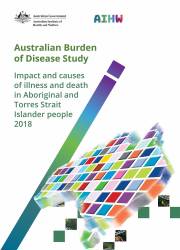Summary
Every year in Australia, many years of healthy life are lost because of injury, illness or premature deaths in the population. This loss of healthy life is called the ‘burden of disease’ in epidemiological literature.
Burden of disease analysis combines the impact of living with poor health (the non-fatal burden of disease) with dying prematurely (fatal burden). Fatal and non-fatal burden combined is referred to as total burden. Burden of disease is recognised as the best method to measure the impact of different diseases or injuries in a population.
This report presents the results of the Indigenous component of the Australian Burden of Disease Study 2018. It provides estimates of the total, non-fatal and fatal burden of disease and injury for the Aboriginal and Torres Strait Islander population for 2018 using the DALY (disability-adjusted life years) measure. One disability adjusted life year (or 1 DALY) represents 1 year of healthy life lost, either through premature death (‘years of life lost’ or YLL) or from living with an illness or injury (‘years lived with disability’ or YLD). YLD are weighted to account for the severity of disease.
DALY estimates are presented for 219 diseases (which are grouped into 17 disease groups, see Table 1.2), as well as estimates of the burden attributable to 39 individual risk factors, such as tobacco use and physical inactivity. Estimates of the gap in disease burden between Indigenous and non-Indigenous Australians are also presented. Interactive data are available online.
In 2018, Indigenous Australians lost 240,000 years of healthy life (total burden, DALY) due to:
 Living with illness or injury (non-fatal) 53% of total burden
Living with illness or injury (non-fatal) 53% of total burden
 Dying prematurely (fatal)
Dying prematurely (fatal)
47% of total burden
Summary
-
Introduction
-
Total burden of disease
-
Non-fatal burden of disease
-
Fatal burden of disease
-
Contribution of risk factors to burden
-
Gap in health outcomes
-
Changes over time
-
Health-adjusted life expectancy
-
Overview of results by disease group
-
Variation across geographic and population groups
-
Data gaps and opportunities
Appendix A: Methods overview
Appendix B: How reliable are the estimates?
Appendix C: Understanding and using burden of disease estimates
Appendix D: Additional tables and figures
End matter: Acknowledgments; Abbreviations; Symbols; Glossary; List of tables; List of figures; List of boxes; Related publications



